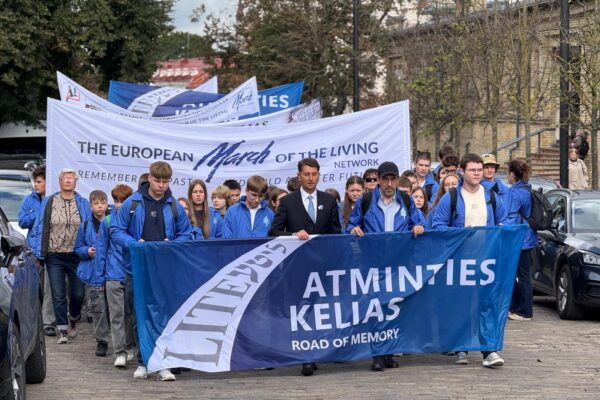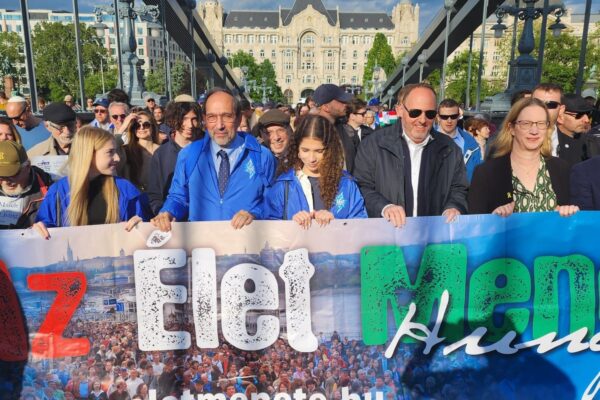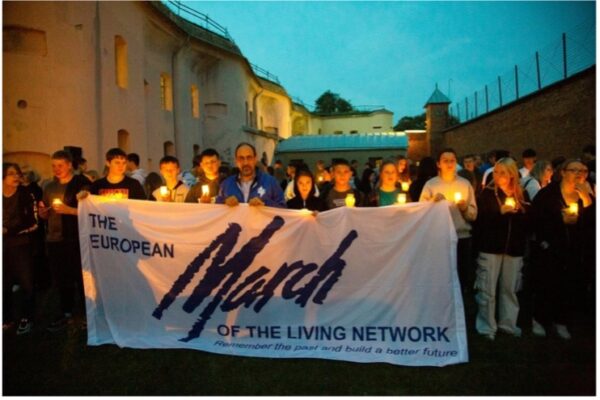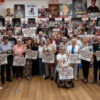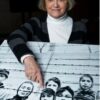
On August, 29, 1944, 80 years ago, the last transport of Jews from the Lodz Ghetto left for Auschwitz Birkenau.
During WWII, approximately 210,000 Jews were forced to live in the Lodz Ghetto, under the most inhumane conditions, most of whom were murdered in the nearby Chelmno death camp.
On August 29, 2024, the Radegast train station in Lodz was the site of a moving memorial ceremony and Joint March of Remembrance and March of the Living. The ceremony and March commemorated the last deportation of Jews remaining in the Lodz Ghetto – the second largest Ghetto in Nazi occupied Europe – to Auschwitz.
The main event at the Radestag train station, which included a wreath-laying ceremony, was attended by some 450 people, including many Polish officials and ambassadors of some 12 countries. The ceremony was followed by a march to the Monument to the Martyrdom of Children, the Monument to Poles Saving Jews in the Survivors’ Park and the Roma Forge, ending at the Monument to the Decalogue in Łódź.
A number of aging Holocaust survivors attended, including:
98 year old Leon Weintraub, who survived Ghetto Lodz, four concentration camps, as well as a death march; Noted Holocaust Survivor Marian Turski who insisted on joining the ceremony and marching together with those assembled; two other Holocaust survivors: Joseph Salomonovic and Hana Svirsky who also spoke at the ceremony together with Leon Weintraub.
The ceremony and march were sponsored by International March of the Living , TSKZ, the Lodz Archdiocese and the Jewish Community of Lodz.
In his remarks, Michel Gourary – Director of the European March of the Living, paid tribute to those in the Lodz Ghetto, Jewish and non-Jewish, who resisted Nazi tyranny.
They included:
Israel Kristal, who survived both the Łódź Ghetto and Auschwitz. He lived to become the world’s oldest man, passing away a few years ago just before his 114th birthday
Stanislawa Leszczyńska, a Catholic midwife, who helped many Jews by giving them food and false documents. She and her daughter were sent to Auschwitz – her sons to Mauthausen.
Oskar Rosenfeld who worked tirelessly to document life in the ghetto and the atrocities committed there, and photographer Henryk Ross who took secret photos, and writer Dawid Sierakowiak who kept diaries, and Shmuel Rozensztajn, who sent out messages about the horrors happening in the ghetto, hoping to alert the world.

Holocaust survivor Leon Weintraub (white jacket) overlooking Michelle Gourary speaking.
Read Michel Gourary’s full remarks below
–===============================
Remarks of Michel Gourary – Director of the European March of the Living – 29/8/2024
Ladies and gentlemen, distinguished guests, dear participants,
The March of the Living is proud to partner with TSKZ, the Lodz Archdiocese and the Jewish Community of Lodz in organizing this Joint March of Remembrance on the 80th commemoration of the liquidation of Litzmannstadt Ghetto.
We are here today, 80 years after the last train left this station for Auschwitz on August 29, 1944. We gather to remember those who suffered in the Łódź Ghetto and to share some lesser-known stories of resilience, courage and strength.
Our aim at the March of the Living is to educate the young generation to learn from the tragic past of the Holocaust, in order to build a better future.
Since its inception in 1988, the March of the Living brought some 300,000 individuals from 52 countries from all over the world to Poland in order to study the history of the Holocaust and to examine the roots of prejudice, intolerance and hate.
The Łódź Ghetto, created in April 1940, was not just a cruel Labor camp and a site of suffering—it was also a place where we found the resilience of the human spirit in the most unexpected ways.
Because of its remarkable productivity in 117 workshops despite starvation and the lack of food, the Ghetto managed to survive until August 1944. It lasted longer than any other ghetto.
Within the ghetto, there were also special camps. One was for Polish Christian children aged 8 to 14, who were orphans or accused of crimes. Another camp held 5,000 Roma and Sinti (Gypsies), who suffered greatly alongside the Jewish people in the ghetto.
In 1941, 20,000 Jews were sent to the Łódź Ghetto from Austria, Germany, Luxembourg, and Czechoslovakia. These people arrived in a ghetto that was already too crowded, with many dying from hunger and disease. Their story reminds us of the widespread suffering caused by the Nazis.
One person who survived both the Łódź Ghetto and Auschwitz was Israel Kristal. He lived to become the world’s oldest man, passing away just before his 114th birthday. His life is a powerful symbol of survival and resilience. In these dark times, some people still tried to help. Stanislawa Leszczyńska, a Catholic midwife, helped many Jews by giving them food and false documents. She was sent with her daughter to Auschwitz, and her sons to Mauthausen. She received the title of Righteous Among the Nations for her courageous actions.
Even in such difficult times, people in the Łódź Ghetto resisted in different ways. They set up schools, theaters, and organized religious gatherings, community and even municipal services helping them stay strong against the Nazis’ attempts to dehumanize them.
Members of the underground, including people like Oskar Rosenfeld worked tirelesly to document life in the ghetto and the atrocities committed there. Others, like photographer Henryk Ross, took secret photos, and young writer Dawid Sierakowiak kept diaries.
Some, like Shmuel Rozensztajn, risked their lives to send out messages about the horrors happening in the ghetto, hoping to alert the world.
These records show us the courage and strength of these people, and they help us remember what happened so we can draw the lessons for the present and for the future.
We must ensure that what happened during the Holocaust is never forgotten. Am Israel Hai
Thank you.
